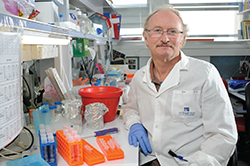
The p53 gene is known as the “guardian of the genome” because it plays a key role in preventing healthy cells from turning cancerous. When p53 is mutated, however, it loses this function. This is significant, as more than 50 percent of all human cancers involve defects, mutations, or other alterations in the p53 gene.
“No other gene is implicated in so many cancers,” says Prof. Moshe Oren of the Weizmann Institute of Science’s Department of Molecular Cell Biology. “It makes you want to understand why.”
“We need to bring together people who understand the biology of cancer with people who know how to work with big data, such as computer scientists, mathematicians, and theoretical physicists.”
A scientist is, in many ways, a detective, working through clues to “understand why.” In fact, Prof. Oren compares p53 to a sniffer dog, leading scientists to cancer and pointing them toward the essential facts.
For 35 years, Prof. Oren has studied the way p53 works in both normal and cancerous cells. In the early 1980s, he cloned p53 – in other words, he determined the sequence of its genetic letters. This breakthrough enabled scientists across the globe to greatly expand their p53 research, since they could now make many copies of the gene for a range of experiments. Prof. Oren was also the first in the world to prove that p53 causes apoptosis, the natural process that leads to cell death.
“Our experiments revealed that p53 controls the apoptosis mechanism, which serves to protect us by instructing cancer cells to commit suicide,” explains Prof. Oren. “Apoptosis is the first line of defense in preventing a single renegade cancer cell from turning into an aggressive tumor.” He also showed that reactivation of p53 in cancer cells can prompt them to self-destruct, which has led to a major effort, by both academia and “big pharma,” to identify drugs or compounds that can trigger this reactivation in cancer patients. Prof. Oren states that “there’s a lot of effort being put into developing such drugs, but it’s not going to be simple,” adding: “I hope that it won’t take too long until we see something real coming from academic p53 research into the clinical practice.”

Prof. Moshe Oren
Still another of Prof. Oren’s discoveries being explored as a cancer treatment is a protein called Mdm2. In the 1990s, he and his team discovered that Mdm2 is a major regulator of p53 activity. Its job is to ensure that p53 levels in healthy cells are tightly controlled, which it does by continually destroying any surplus p53 molecules; however, if Mdm2 becomes overly active, it might remove too much, thus depriving the cell of a vital tumor suppressor mechanism. Such excessive activity of Mdm2 is found in 10 to 20 percent of all cancers, particularly in sarcomas and in certain types of leukemia. Drugs that block Mdm2 so as to prevent excessive destruction of p53 are in clinical trials by several major pharmaceutical companies.
The new Moross Integrated Cancer Center is dedicated to producing the finest basic research on cancer prevention, diagnosis, and treatment, and then moving findings from the lab to the clinic.
Throughout his decades of working with p53 and accruing accolades, such as the 2008 Israel Prize for biochemistry, Prof. Oren has kept his curiosity about that gene: “The more we learn about p53, the more we see that it teaches us fundamental lessons about every aspect of cancer.”
Such curiosity and understanding will serve Prof. Oren well in his role as head of the Weizmann Institute’s new Moross Integrated Cancer Center (MICC). A flagship project of the Institute, it is dedicated to producing the finest basic research on cancer prevention, diagnosis, and treatment, and then moving findings from the lab to the clinic as quickly and efficiently as possible. But the MICC isn’t limited to Weizmann Institute scientists: its investigators plan collaborations with academic researchers, clinicians, and industry experts, not only from across Israel, but from around the world.
“In my mind, the big challenge for cancer research is the one of complexity,” says Prof. Oren. “We can now get very precise information on each and every gene in a tumor and all the changes taking place in it. But how do we interpret these huge amounts of data?”
One of his goals for the MICC is to tap into Weizmann’s strength in multidisciplinary research, utilizing the expertise of scientists in other fields to help make sense of large sets of biological data. “We need to bring together people who understand the biology of cancer with people who know how to work with big data, such as computer scientists, mathematicians, and theoretical physicists,” he says.
The more we learn about the p53 gene, the more we see that it teaches us about every aspect of cancer.
Fortunately, the Weizmann Institute has outstanding researchers in these and other fields. As Prof. Oren says, “They are all within the campus, they are all working next to each other – this is the unique feature of the Institute. We have a strong tradition of working together. This is not something that we need to invent.”
Prof. Moshe Oren’s research is supported by the Moross Integrated Cancer Center, which he heads; the Dr. Miriam and Sheldon G. Adelson Medical Research Foundation; the Rosenwasser Fund for Biomedical Research; the Robert Bosch Foundation; the United Breast Cancer Research Society; and the European Research Council. Prof. Oren is the incumbent of the Andre Lwoff Professorial Chair in Molecular Biology.
